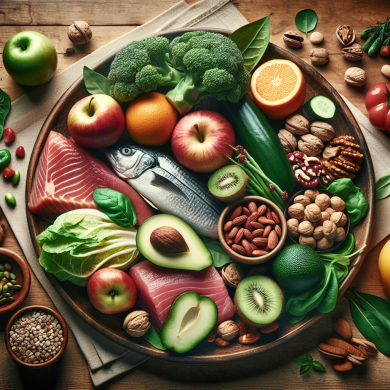Kickstart Paleo Diet: Essential Beginner Tips
Introduction to the Paleo Diet
The Paleo diet, often referred to as the “caveman diet,” is a dietary regimen that seeks to emulate the eating patterns of our Paleolithic ancestors. The premise is simple: if our ancestors didn’t eat it, neither should we. This means focusing on whole, unprocessed foods like meats, fish, fruits, vegetables, nuts, and seeds while avoiding processed foods, grains, legumes, and dairy. The idea is that by eating like our ancestors, we can improve our health and well-being.
The Evolution of the Paleo Diet
While the Paleo diet might seem like a new trend, its roots can be traced back to the 1970s when gastroenterologist Dr. Walter L. Voegtlin first introduced the concept in his book “The Stone Age Diet.” However, it wasn’t until the early 21st century that the diet gained mainstream popularity, largely due to the work of Dr. Loren Cordain, a professor in the Department of Health and Exercise Science at Colorado State University. Dr. Cordain’s research and books helped spread the idea that modern diseases could be alleviated or even prevented by adopting a diet similar to that of our Paleolithic ancestors.
Benefits of the Paleo Diet
The Paleo diet boasts several potential health benefits, making it appealing to many. Here are some of the primary advantages:
- Weight Loss: By eliminating processed foods and focusing on nutrient-dense options, many people experience weight loss.
- Improved Digestion: A diet rich in fruits, vegetables, and lean proteins can help enhance digestive health.
- Better Blood Sugar Control: By avoiding refined sugars and carbs, the Paleo diet can help stabilize blood sugar levels.
- Increased Energy Levels: The diet’s emphasis on whole foods can lead to more consistent energy throughout the day.
- Reduced Inflammation: By cutting out processed foods and focusing on anti-inflammatory options like fish and vegetables, the diet may help reduce inflammation in the body.
Getting Started: Essential Tips for Paleo Beginners
1. Educate Yourself
Before diving into the Paleo diet, it’s crucial to understand its principles and guidelines. Read books, browse reputable websites, and consider consulting with a nutritionist to ensure you’re well-informed about the diet’s requirements and potential challenges.
2. Stock Your Kitchen
Transitioning to a Paleo diet is much easier when your kitchen is stocked with the right foods. Fill your pantry and fridge with fresh fruits, vegetables, lean meats, fish, eggs, nuts, and seeds. Consider removing all processed foods, grains, legumes, and dairy products to avoid temptation.
3. Meal Planning and Preparation
One of the best ways to stick to the Paleo diet is through meal planning and preparation. Set aside time each week to plan your meals, create a shopping list, and prepare some dishes in advance. This will help you avoid last-minute unhealthy food choices and ensure you always have Paleo-friendly meals on hand.
4. Start Gradually
While some people prefer to dive headfirst into the Paleo diet, others find it more manageable to transition gradually. Begin by eliminating processed foods and gradually phase out grains, legumes, and dairy. This approach can help you adjust to the changes and make the diet more sustainable in the long term.
5. Listen to Your Body
As you begin the Paleo diet, pay close attention to how your body responds. Everyone’s nutritional needs are different, so it’s essential to listen to your body’s signals. If you’re feeling fatigued or experiencing digestive issues, consider adjusting your food choices or consulting a healthcare professional.
6. Stay Hydrated
Proper hydration is crucial for overall health, especially when following the Paleo diet. Make sure you’re drinking enough water throughout the day to support digestion, nutrient absorption, and energy levels. Herbal teas and coconut water can also be excellent choices for staying hydrated.
7. Be Mindful of Nutrient Intake
While the Paleo diet emphasizes nutrient-dense foods, it’s still essential to ensure you’re getting a balanced intake of vitamins and minerals. Pay attention to your consumption of iron, calcium, vitamin D, and omega-3 fatty acids, which are crucial for overall health. If necessary, consider using supplements to fill any nutritional gaps.
Paleo-Friendly Foods to Enjoy
- Lean Meats: Beef, lamb, chicken, turkey, and pork.
- Fish and Seafood: Salmon, mackerel, sardines, and shellfish.
- Fruits: Berries, apples, bananas, oranges, and avocados.
- Vegetables: Leafy greens, broccoli, cauliflower, peppers, and carrots.
- Nuts and Seeds: Almonds, walnuts, cashews, chia seeds, and flaxseeds.
- Healthy Fats: Olive oil, coconut oil, and avocado oil.
Foods to Avoid on the Paleo Diet
- Processed Foods: Fast food, packaged snacks, and sugary treats.
- Grains: Wheat, rice, oats, and barley.
- Legumes: Beans, lentils, peanuts, and soy.
- Dairy Products: Milk, cheese, yogurt, and butter (some versions of the diet allow grass-fed butter).
- Refined Sugars: Table sugar, corn syrup, and artificial sweeteners.
- Refined Oils: Vegetable oils, canola oil, and margarine.
Common Challenges and How to Overcome Them
1. Social Situations
Dining out or attending social events can be challenging when following the Paleo diet. To minimize stress, research restaurant menus in advance, and don’t hesitate to ask for modifications. When attending gatherings, consider bringing a Paleo-friendly dish to share with others.
2. Cravings and Hunger
It’s natural to experience cravings, especially in the early stages of the Paleo diet. Combat these by ensuring your meals are balanced and satisfying. Incorporate healthy fats, proteins, and fiber-rich foods to keep you full and curb cravings. Keep Paleo-friendly snacks on hand, such as nuts and fruits, to help you stay on track.
3. Nutritional Deficiencies
Without careful planning, the Paleo diet can lead to certain nutrient deficiencies. To avoid this, focus on incorporating a wide variety of fruits, vegetables, and protein sources into your meals. If you suspect you may be lacking in specific nutrients, consult a healthcare professional for guidance and consider supplements if necessary.
Conclusion: Embracing the Paleo Lifestyle
Starting the Paleo diet is a journey towards better health and well-being. By focusing on whole, unprocessed foods and making mindful choices, you can experience the numerous benefits this dietary approach offers. Remember that everyone’s journey is unique, so be patient with yourself and make adjustments as needed to suit your individual needs.
With the right mindset, preparation, and dedication, you can successfully embrace the Paleo lifestyle and enjoy a healthier, more balanced life.















Add comment